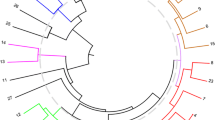Abstract
Genetic relationships were examined among thirty-four pepper (Capsicum annuum) cultivars of different types. Two types of PCR-based markers were used, RAPD and AFLP, and their relative effectiveness was compared. A dendrogram based on RAPD markers separated the large-fruited sweet cultivars from the small-fruited pungent peppers, and the former group showed less divergence than the latter. The percentage of polymorphic markers was lower for AFLP than for RAPD markers (13 and 22% respectively). However, AFLP primers amplified on average six times more products than RAPD markers. The average numbers of polymorphic products per primer were 1.6 and 6.5 for RAPD and AFLP primers, respectively, i.e., AFLP primers were four times more efficient than RAPD primers in their ability to detect polymorphism in pepper. While four blocky type cultivars were indistinguishable by RAPD, two AFLP primer pairs were sufficient to distinguish the four cultivars from each other.
Similar content being viewed by others
References
Cho, Y.G., M.W. Blair, O. Panaud & S. McCouch, 1996. Cloning and mapping of varietyspecific rice genomic DNAsequences: amplified restriction fragment polymorphism (AFLP) from silverstained polyacrylamide gels. Genome 39: 373–378.
Conicella, C., A. Errico & F. Saccardo, 1990. Cytogenetic and isozyme studies of wild and cultivated Capsicum annuum. Genome 33: 279–282.
Doyle, J.J. & J.L. Doyle, 1990. Isolation of plant DNA from fresh tissue. Focus 12: 13–14.
Folkertsma, R.T., J.N.A.M. Rouppe van der Voort, K.E. de Groot, P.M. van Zandvoort, A. Schots, F.J. Gommers, J. Helder & J. Bakker, 1996. Gene pool similarities of potato cyst nematode populations assessed by AFLP analysis. Mol Plant-Microbe Interactions 9: 47–54.
Jaccard, P., 1908. Nouvelles recherches sur la distribution florale. Bull Soc Vaud Sci Nat 44: 223–270.
Lefebvre, V., A. Palloix & M. Rives, 1993. Nuclear RFLP between pepper cultivars (Capsicum annuum L.). Euphytica 71: 189–199.
Lefebvre, V., A. Palloix, C. Caranta & E. Pochard, 1995. Construction of an intraspecific integrated linkage map of pepper using molecular markers and doubled-haploid progenies. Genome 38: 112–121.
Loaiza-Figueroa, F., K. Ritland, J.A. Laborde Cancino & S.D. Tanksley, 1989. Patterns of genetic variation of the genus Capsicum (Solanaceae) in Mexico. Pl Syst Evol 165: 159–188.
Maughan, P.J., M.A. Saghai Maroof, G.R. Buss & G.M. Huestis, 1996. Amplified fragment length polymorphism (AFLP) in soybean: species diversity, inheritance, and near-isogenic line analysis. Theor Appl Genet 93: 392–401.
McLeod, M.J., S.I. Guttman, W.H. Eshbaugh & R.E. Rayle, 1983. An electrophoretic study of evolution in Capsicum (Solanaceae). Evolution 37: 562–574.
Milbourne, D., R. Meyer, J.E. Bradshaw, E. Baird, N. Bonar, J. Provan, W. Powell & R. Waugh, 1997. Comparison of PCRbased marker systems for the analysis of genetic relationships in cultivated potato. Mol Breeding 3: 127–136.
Paran, I., R. Kesseli & R.W. Michelmore, 1991. Identification of restriction fragment length polymorphism and random amplified polymorphic DNA markers linked to downy mildew resistance genes in lettuce using near-isogenic lines. Genome 34: 1021–1027.
Pickersgill, B., 1988. The genus Capsicum: a multidisciplinary approach to the taxonomy of cultivated and wild plants. Biol Zentrabl 107: 381–389.
Prince, J.P., E. Pochard & S.D. Tanksley, 1992. Restriction fragment length polymorphism and genetic distance among Mexican accessions of pepper. Genome 36: 404–417.
Prince, J.P., V.K. Lackney, C. Angeles, J.R. Blauth & M.M. Kyle, 1995. A survey of DNA polymorphism within the genus Capsicum and the fingerprinting of pepper cultivars. Genome 38: 224–231.
SAS, 1988. SAS User's Guide, Version 6, SAS Institute, Inc., Cary, NC.
Thomas, C.M., P. Vos, M. Zabeau, D.A. Jones, K.A. Norcott, B.P. Chadwick & J.D.G. Jones, 1995. Identification of amplified restriction fragment polymorphism (AFLP) markers tightly linked to the tomato Cf-9 gene for resistance to Cladosporium fulvum. Plant J 8: 785–794.
Van Eck, H.J., J. Rouppe van der Voort Draaistra, P. van Zandvoort, E. van Enckevort, B. Segers, J. Peleman, E. Jacobsen, J. Helder & J. Bakker, 1995. The inheritance and chromosomal localization of AFLP markers in a noninbred potato offspring. Mol Breeding 1: 397–410.
Vos, P., R. Hogers, M. Bleeker, M. Reijans, T. van de Lee, M. Hornes, A. Frijters, J. Pot, J. Peleman, M. Kuiper & M. Zabeau, 1995. AFLP: a new technique for DNA fingerprinting. Nucl Acid Res 23: 4407–4414.
Williams, J.G.K., A.R. Kubelik, K.J. Livak, J.A. Rafalsky & S.V. Tingey, 1990. DNA polymorphisms amplified by arbitrary primers are useful as genetic markers. Nucl Acids Res 18: 6531–6535.
Author information
Authors and Affiliations
Rights and permissions
About this article
Cite this article
Paran, I., Aftergoot, E. & Shifriss, C. Variation in Capsicum annuum revealed by RAPD and AFLP markers. Euphytica 99, 167–173 (1998). https://doi.org/10.1023/A:1018301215945
Issue Date:
DOI: https://doi.org/10.1023/A:1018301215945




